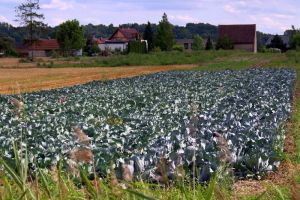Brassica oleracea

Cabbage is a crop that can be planned to be harvested to be harvested all year round. To do this, you need to varieties, densities and planting dates. planting dates. The cabbage strategy involves many small successive series (low marketing potential). Be that as it may cabbage has a low return per m² (around €16/ m²), and is therefore not a structuring element of the farm's but rather a strategic marketing element (attracting strategic marketing element (attracting consumers in off-peak periods)
Preparing the soil
Cabbages will appreciate a 10- 15 cm, as long as they are well planted in the soil so that the so that the root ball does not dry out when transplanted. Cabbage is grown on tarpaulin or organic mulch, and straw is added manually manually to a thickness of 15 to 30 cm to guarantee to ensure no weeding during cultivation. Cabbages like deep soil. In cold weather or for early for early planting, they need more fertiliser due to low mineralisation.
Planting
To withstand pest pressure at planting, cabbage plants need to be stocky and vigorous. To do this, they need few nutrients and little water. To achieve this, the cabbages are sown in trays (30 days before planting) in potting soil. before planting) in shallow soil. The can be laid on the ground (the roots will look for food in the soil) and dried. the soil for food) and shaken from time to time (to break up some of the roots and stimulate the production of new roots)".
Another technique involves watering the plants less a week before transplanting. A cabbage plant ready for planting has a woody, purplish hypocotylar axis. Caution, these hardening techniques do not apply to not apply to Chinese cabbages, which behave more like salads. salads. Planting and planting holes are done by hand or with a bucket planter.
Monitoring cultivation
For cabbages, while weed cover must be limited at the start of the crop at the beginning of the crop, it can be more substantial at the end without this being detrimental.
For cauliflowers, you need to protect the head from the sun by breaking off a leaf to cover it : this ensures that it remains remains white.
In the case of Chinese cabbage, seed set is induced by the induced by the lengthening days, beyond 14 hours.
Irrigation
Irrigation is required at planting to ensure that the cabbages of the cabbages. In open fields, autumn crops do not require watering do not require watering, but you will need to be vigilant in the for summer cabbages. Water requirements increase until the apples emerge, then decrease.
Beware of sudden bursts of irrigation (too much or which can lead to bolting.
Harvest
Harvesting takes place when the cabbages are well formed and the the head is dense. It may be advisable to let (especially Broccoli) which will be harvested a second time. harvested in a second pass.
Tip
A daily check just after planting can be used to monitor watering, slugs and flea beetles. This ensures a successful crop.
Storage
Cabbages store well in the field. Very severe frosts will cause some damage. White and red white and red cabbages can be stored in paloxes in straw, for example.
Varieties
Be careful to choose varieties suited to the season : there are short-cycle (early) and long-cycle (autumn, winter) cabbages.
- Autumn pointed cabbage : Coeur de boeuf (sow in autumn and transplant in January). Rouge tête noire (grown all year round).
- Kale : Milan de Pontoise (excellent, not too curly, a little purple).
Pests and diseases
There are several common problems with cabbage :
- Flea beetles, which damage young plants in dry periods. Very fine mesh insect netting installed at the start of the crop provides good protection.
- Slugs attacking young plants
- Cabbage maggot, depending on flight periods. Nets protect the crop. On well-fed cabbages in living soil, the whitefly does not really pose a problem.
Adapting to the soil and climate
In warmer regions, it is possible to grow cabbages planted in autumn for a very early harvest the following spring. following spring.
On the other hand, beware in these regions of the production of which can be complicated. Straw helps to the crop and prevents it going to seed.
Possible ITK variations
Cabbages can be planted in a tarpaulin (woven or silage). or silage). This allows weed control by hiding of the beds.
Photo gallery
Sources
- This page is based on the guide Introduction au maraîchage sol vivant from MSV Normandie.
